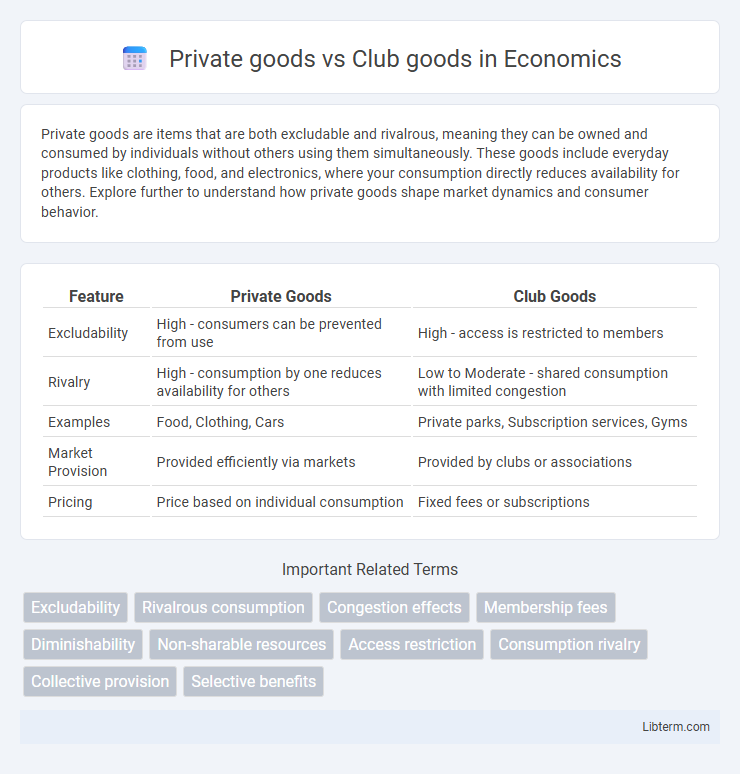Private goods are items that are both excludable and rivalrous, meaning they can be owned and consumed by individuals without others using them simultaneously. These goods include everyday products like clothing, food, and electronics, where your consumption directly reduces availability for others. Explore further to understand how private goods shape market dynamics and consumer behavior.
Table of Comparison
| Feature | Private Goods | Club Goods |
|---|---|---|
| Excludability | High - consumers can be prevented from use | High - access is restricted to members |
| Rivalry | High - consumption by one reduces availability for others | Low to Moderate - shared consumption with limited congestion |
| Examples | Food, Clothing, Cars | Private parks, Subscription services, Gyms |
| Market Provision | Provided efficiently via markets | Provided by clubs or associations |
| Pricing | Price based on individual consumption | Fixed fees or subscriptions |
Introduction to Private Goods and Club Goods
Private goods are defined by their excludability and rivalry, meaning consumers can be prevented from using them, and one person's consumption reduces availability for others. Club goods, however, are excludable but non-rivalrous up to a point, allowing multiple consumers to enjoy the good simultaneously without depletion. Understanding these distinctions is essential for economic allocation and management of resources such as bandwidth or subscription services.
Defining Private Goods: Characteristics and Examples
Private goods are defined by their rivalrous and excludable nature, meaning consumption by one individual reduces availability for others and access can be restricted. Common examples include food items, clothing, and cars, where individual ownership prevents simultaneous use by others. These goods require direct purchase and are typically sold in competitive markets due to their clear exclusion and rivalry properties.
Understanding Club Goods: Key Features and Illustrations
Club goods are characterized by their excludability and non-rivalrous consumption, meaning access can be limited to paying members while use by one individual does not reduce availability for others. Examples include subscription-based streaming services, private golf courses, and gym memberships, where exclusive access is maintained but simultaneous use by multiple members is feasible. Understanding these key features helps differentiate club goods from private goods, which are both excludable and rivalrous, such as a personal laptop or a sandwich.
Excludability and Rivalry: Core Distinctions
Private goods exhibit both high excludability and rivalry, meaning consumers can be prevented from using them and one person's consumption reduces availability for others. Club goods feature high excludability but low rivalry, allowing providers to restrict access while multiple users simultaneously benefit without diminishing the good's utility. These core distinctions influence market dynamics, pricing strategies, and resource allocation efficiency in economic theory.
Real-World Examples: Private Goods vs Club Goods
Private goods, such as smartphones and clothing, are rivalrous and excludable, meaning consumption by one person prevents others from using them, and access can be restricted through purchase. Club goods, like subscription-based streaming services (Netflix, Spotify) and private golf courses, are non-rivalrous up to a point but excludable, allowing multiple users simultaneous access without competition for the resource. Real-world distinctions are evident in parking spaces (private good) versus a gym membership (club good), where exclusive use and accessibility define their economic classification.
Consumption Patterns and Accessibility
Private goods exhibit rivalrous consumption patterns, meaning one individual's use reduces availability for others, and access is strictly restricted through market mechanisms such as pricing. Club goods, characterized by non-rivalrous consumption up to a capacity limit, allow multiple users simultaneous access without diminishing the good for others, yet require membership or subscription for entry. Accessibility to private goods depends solely on willingness and ability to pay, whereas club goods balance exclusivity and shared consumption through controlled access policies.
Economic Efficiency and Resource Allocation
Private goods exhibit high economic efficiency due to their excludability and rivalry, which incentivizes optimal resource allocation through market mechanisms. Club goods, characterized by excludability but non-rivalry up to a capacity limit, require regulated access to prevent congestion and maintain efficient resource use. Efficient allocation in club goods often involves pricing strategies or membership controls to balance provision costs and user benefits, minimizing deadweight loss while promoting sustainable consumption.
Challenges in Managing Private and Club Goods
Managing private goods involves challenges such as ensuring exclusive ownership rights, preventing free riding, and addressing issues of overuse or depletion in case of rivalrous consumption. Club goods require balancing accessibility with congestion control, as non-excludability within the club can lead to overcrowding, reducing the benefit for members. Efficient management of both goods demands tailored policies that address the unique rivalry and excludability characteristics specific to private and club goods.
Impacts on Consumers and Producers
Private goods provide exclusive consumption, ensuring that consumers pay directly for products like food and clothing, which supports clear market pricing and efficient resource allocation for producers. Club goods, such as subscription services and private parks, offer non-rivalrous benefits within a defined group, allowing producers to capitalize on economies of scale and create value through controlled access. Consumer impacts vary as private goods foster individual choice and competition, while club goods emphasize shared benefits and membership incentives, influencing market strategies and consumer satisfaction.
Conclusion: Comparing Private and Club Goods
Private goods are rivalrous and excludable, meaning consumption by one individual reduces availability for others and access can be restricted. Club goods are non-rivalrous up to a capacity limit and excludable, allowing group members to share benefits without immediate depletion but excluding non-members. The key distinction lies in rivalry: private goods diminish with use, while club goods maintain utility for users until congestion occurs, impacting resource allocation and access policies.
Private goods Infographic

 libterm.com
libterm.com